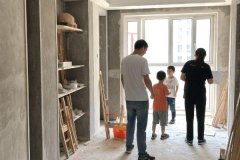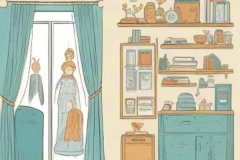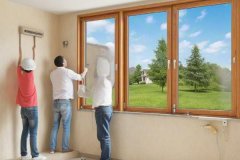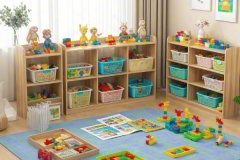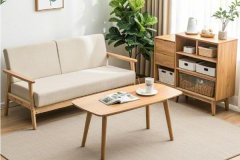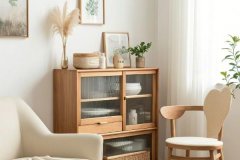How to organize a kids' playroom effectively
How to Organize a Kids' Playroom Effectively
A well-organized playroom not only helps keep clutter at bay but also fosters creativity, independence, and a sense of responsibility in kids. However, with so many toys, books, games, and activities to manage, organizing a playroom can seem like a daunting task. The key is to create an environment where everything has its place, and the space is both functional and fun. Here’s a guide to help you organize a kids' playroom effectively while making it an enjoyable space for your little ones.
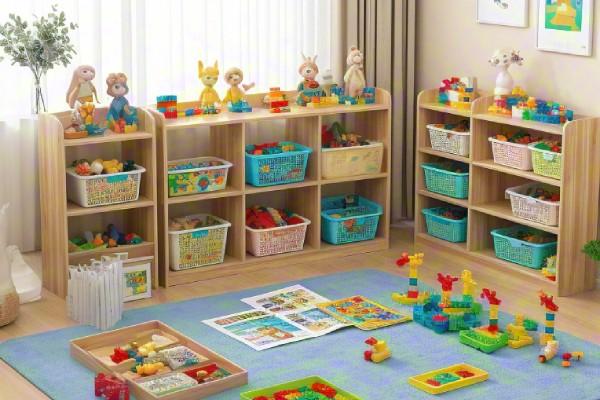
1. Categorize and Declutter
The first step in organizing a kids' playroom is to declutter and categorize all the items. This helps to identify what you have and decide what needs to stay and what can go.
Suggestions:
- Sort by Categories: Group toys and materials by type, such as action figures, dolls, puzzles, art supplies, educational toys, and books. This will help you determine the storage solutions needed for each category.
- Purge Unused Items: Go through the toys and games and get rid of broken, outdated, or unused items. Consider donating toys that no longer hold interest or are in good condition but not used frequently.
- Involve Your Kids: Make decluttering a fun family activity. Ask your kids to help decide what to keep and what to donate. It’s a great way to teach them about responsibility and organizing.
Why It Works:
Decluttering and categorizing toys will prevent overwhelming messes and allow for easier access to items that are frequently used. It also creates a more efficient, manageable storage system.
2. Use Clearly Labeled Storage Solutions
Investing in proper storage solutions can make a huge difference in keeping the playroom organized. When everything has a designated place, kids can easily find what they need and put it back when they’re done.
Suggestions:
- Bins and Baskets: Use clear bins or baskets to store smaller toys and keep similar items together. Label each bin with a picture or word to help kids easily identify what belongs inside.
- Toy Storage Cubes: Cube storage units with fabric bins are a great way to organize toys, books, and games. These are easy to access and can be stacked for vertical storage.
- Toy Chests with Lids: A toy chest can be a great option for larger toys that don’t fit in bins. Choose one with a soft close lid for safety and easy access.
- Wall-Mounted Storage: Consider installing shelves or wall-mounted pockets to store books, stuffed animals, or art supplies, keeping floor space clear.
Why It Works:
Labeled storage makes it easier for kids to understand where each item goes, encouraging them to put toys away. Clear bins help with visual identification, and sturdy containers ensure long-term organization.
3. Create Zones for Different Activities
Dividing the playroom into specific activity zones can keep the space organized and ensure there’s a dedicated area for every activity. This way, your kids can enjoy various types of play without mixing everything up.
Suggestions:
- Reading Nook: Create a cozy reading corner with soft cushions, shelves of books, and good lighting. Keep the books organized by genre, size, or favorite series.
- Creative Zone: Dedicate a corner for art and crafts, with supplies like crayons, markers, paper, and glue organized in bins or drawers. Consider adding an easel or table for creative activities.
- Building Zone: Set up a play area with building blocks, Legos, or construction toys. Store them in separate bins based on size and type to keep the area tidy and prevent pieces from getting mixed up.
- Quiet Play Area: If space allows, create a quiet area for puzzles, board games, or imaginative play. A rug, some pillows, and low shelves can turn any corner into a calm play zone.
Why It Works:
Designating zones for specific activities helps maintain order and allows kids to easily transition from one activity to another without making a mess of everything. It also supports a variety of play types, from imaginative play to quiet reading time.
4. Make Cleaning Up Fun and Easy
A key to maintaining an organized playroom is making cleanup easy and even enjoyable for kids. When kids can easily put things back in their proper place, they’re more likely to help and take ownership of their space.
Suggestions:
- Incorporate Fun Labels: Add colorful labels with pictures to storage bins and shelves to make cleaning up more fun. You can even use chalkboard labels that kids can personalize.
- Clean-Up Time Routine: Turn cleaning up into a game or challenge. Set a timer and see how quickly the kids can pick up all their toys, or make it a race to see who can match the most toy pieces together.
- Accessible Storage: Make sure storage bins and shelves are at a height that’s easy for kids to reach, encouraging them to put toys back after they’re done playing. Low shelves and bins promote independence.
- Toy Rotation: If your playroom is overflowing, consider rotating toys in and out of storage. This helps keep the playroom fresh and prevents overwhelming clutter.
Why It Works:
Making cleanup fun and easy encourages kids to take part in organizing their space and developing good habits. When toys are easily accessible and storage is child-friendly, cleaning up becomes less of a chore.
5. Maximize Vertical Space
If floor space is limited, consider using the vertical space in the room. Shelving units, hooks, and other wall-mounted storage options can help you store toys, books, and supplies without taking up precious square footage.
Suggestions:
- Tall Shelving Units: Install tall bookshelves or storage units to maximize vertical space while keeping the lower shelves open for easy access.
- Hooks and Pegboards: Use hooks or pegboards on the walls to hang bags, dress-up clothes, or hats. This is also a great way to keep smaller items off the floor and organized.
- Wall-Mounted Toy Organizers: Consider hanging pockets, mesh organizers, or toy nets on the walls to store plush toys, balls, or stuffed animals. These keep items contained while utilizing unused wall space.
Why It Works:
Using vertical space frees up floor area for play while keeping toys organized and within reach. It also adds more storage without overcrowding the room, which helps maintain a tidy and functional space.
6. Create Flexible Storage for Growing Needs
As your children grow, so do their needs and interests. Choose storage solutions that can evolve with them and can adapt to new types of play or hobbies.
Suggestions:
- Modular Storage Units: Modular shelves, bins, and cubbies that can be adjusted or expanded as your kids’ collections grow are a great way to ensure long-term functionality.
- Adjustable Shelving: Install adjustable shelves to allow for flexible storage that can be customized to store different items as your child’s toys, books, and games change over time.
- Multi-Use Furniture: Invest in furniture that can grow with your child, such as a toy chest that becomes a bench or a bookshelf that turns into a desk.
Why It Works:
Flexible storage allows your playroom to adapt as your child’s needs change. By planning ahead, you can create an organized space that lasts as your child grows and their interests evolve.
7. Keep It Fun and Inviting
Finally, remember that a playroom should feel fun and inviting. An organized space is important, but creating an atmosphere that encourages play and imagination is key to making it a place your child enjoys spending time in.
Suggestions:
- Incorporate Fun Colors: Choose bright, cheerful colors for the walls, furniture, and storage bins. Bold colors can stimulate creativity and make the space feel more engaging.
- Personalize the Space: Add personalized touches such as your child’s name or favorite characters to storage bins or furniture. This will help them feel a sense of ownership in the space.
- Interactive Decor: Consider adding interactive elements like a chalkboard wall, a wall-mounted game, or a mural that your child can contribute to over time.
Why It Works:
A playroom should be a space where kids feel inspired and comfortable. Keeping the space fun, colorful, and personalized makes the playroom an exciting place for your child to explore, learn, and grow.
Final Thoughts
Organizing a kids' playroom effectively requires a mix of thoughtful planning, clever storage solutions, and a focus on creating an environment that is both functional and fun. By categorizing toys, incorporating labeled storage, and creating zones for different activities, you can keep the room organized while encouraging creativity and independence. With the right furniture and a bit of creativity, the playroom can remain tidy and inviting, offering your child a space where they can play, learn, and thrive.
How to Organize a Playroom on a Budget
Creating a well-organized playroom doesn't have to break the bank. With a little creativity and resourcefulness, you can maximize your space and keep it clutter-free without spending a lot of money. From repurposing old furniture to using affordable storage solutions, here are some budget-friendly tips to help you organize your kids' playroom while staying within your budget.
1. Repurpose Existing Furniture
Instead of purchasing expensive new furniture, consider repurposing pieces you already own. Many items around your home can be transformed into functional storage for toys, books, and other playroom essentials.
Suggestions:
- Old Dressers or Cabinets: If you have an old dresser or cabinet, consider painting it in fun, bright colors and using it to store toys or craft supplies. You can add new knobs or handles for a quick upgrade.
- Unused Bookcases or Shelves: Repurpose old bookcases to store toys, puzzles, and games. If necessary, add storage bins or baskets to the shelves to keep things neat.
- Storage Bins and Containers: Use bins, baskets, or boxes you already have to store toys and other play items. You can stack or organize them based on the type of toys, such as dolls, blocks, or books.
Why It Works:
Repurposing furniture saves you money while also giving new life to old items. These solutions are practical, cost-effective, and help reduce waste.
2. Use Affordable Storage Bins and Baskets
Affordable storage bins and baskets are some of the best solutions for organizing a playroom on a budget. You don’t need to buy designer storage containers when there are plenty of low-cost options available at discount stores, thrift shops, or even online marketplaces.
Suggestions:
- Plastic Storage Bins: Plastic bins with lids are inexpensive and perfect for organizing toys. Choose clear ones so kids can easily see what’s inside.
- Fabric Baskets: Fabric baskets or bins are affordable, lightweight, and come in various colors and sizes. They’re great for storing small toys, craft supplies, or even stuffed animals.
- Repurpose Shoe Boxes: If you have extra shoe boxes, cover them with wrapping paper or fabric to create fun and inexpensive storage containers for smaller items.
Why It Works:
Affordable storage bins and baskets keep toys organized, accessible, and easy to store. They come in a variety of shapes and sizes, allowing you to customize the storage to fit your space and needs.
3. DIY Wall Storage Solutions
Maximize vertical space in the playroom by creating DIY wall storage solutions. Using wall-mounted storage options allows you to free up floor space and keep toys within easy reach.
Suggestions:
- Wall-Mounted Pegboards: Install a pegboard on the wall and use hooks to hang bags, art supplies, or small toys. This is a simple and affordable way to keep things organized and accessible.
- Shelves or Floating Shelves: Use inexpensive wooden shelves or floating shelves to store books, toys, or decorative items. These shelves can be easily mounted on the wall and provide vertical storage without taking up floor space.
- Tension Rods: For an inexpensive option, install a tension rod in a closet or against a wall to hang small storage baskets or fabric bags. It’s a budget-friendly way to keep things organized and tidy.
Why It Works:
DIY wall storage solutions are both cost-effective and space-saving. By using vertical space, you keep your playroom clutter-free while maximizing storage.
4. Declutter and Simplify
One of the easiest ways to organize a playroom on a budget is to simply declutter and reduce the number of items in the room. By keeping only the toys your kids actually play with, you can create a more organized, open space without spending a dime.
Suggestions:
- Sort and Donate: Go through the toys and donate or sell items that are no longer used or in good condition. Reducing the number of toys helps maintain an organized environment.
- Rotate Toys: Instead of having all toys out at once, rotate toys regularly. Store some away and bring them out later to keep things fresh and prevent clutter from accumulating.
- Limit Toys: Try to avoid buying new toys unless necessary. Fewer toys mean less mess and a more organized playroom.
Why It Works:
Decluttering and simplifying your child’s playroom is a cost-free way to make it more organized. By removing excess toys and only keeping the essentials, the space becomes less cluttered and more functional.
5. Use Repurposed Household Items
Instead of buying new storage solutions, use items you already have around the house. Household items can be creatively repurposed to create budget-friendly storage options.
Suggestions:
- Empty Cereal Boxes: Cover cereal boxes with wrapping paper or contact paper to create colorful storage bins for small toys, puzzles, or books.
- Plastic Jars and Containers: Old plastic jars, like those from food items, can be used to store art supplies, crayons, or small toys. Simply wash and label them for easy identification.
- Laundry Baskets: Use large laundry baskets to store larger toys, stuffed animals, or blankets. They can be found cheaply at discount stores and are perfect for organizing bulkier items.
Why It Works:
Repurposing household items for storage is a great way to save money while reducing waste. These creative solutions add a personal touch to your playroom while being both functional and cost-effective.
6. DIY Toy Organization Projects
If you're feeling crafty, consider making your own storage solutions. DIY projects can be a fun and cost-effective way to organize a playroom, and you can customize the projects to fit your space and storage needs.
Suggestions:
- Toy Crates or Wooden Bins: Build simple wooden crates or bins to store toys. You can find inexpensive wood at local hardware stores or repurpose old furniture for the materials.
- Corkboard or Bulletin Boards: Use corkboard or bulletin boards to create a fun area for organizing artwork, schedules, or important papers. It’s a budget-friendly way to keep things in order.
- Toy Hanging Bags: Use fabric scraps or old clothes to sew toy hanging bags that can be attached to the back of doors or on hooks to store smaller items like action figures or dolls.
Why It Works:
DIY toy organization projects let you create customized storage solutions without spending much money. Plus, they can be a fun, creative way to get involved in organizing your child’s space.
7. Maximize Small Furniture
In small playrooms, make use of small, inexpensive furniture pieces that can serve multiple purposes. Look for budget-friendly furniture that offers hidden storage or can double as seating and storage.
Suggestions:
- Storage Ottomans: Use an ottoman with hidden storage inside. It can function as both a seat and a place to store extra toys, books, or craft supplies.
- Coffee Tables with Storage: If your playroom includes a seating area, a coffee table with storage can be a great place to store toys and games.
- Stackable Cubes or Modular Storage: Stackable cube storage units can be rearranged to fit your space and provide versatile storage for toys, books, and games. They’re affordable and easy to assemble.
Why It Works:
Small, multipurpose furniture maximizes space and functionality, allowing you to store toys and supplies efficiently without taking up too much room or spending too much money.
Final Thoughts
Organizing a playroom on a budget is all about using creativity and making the most of what you already have. With a bit of ingenuity, you can create an organized and functional space without breaking the bank. From repurposing old furniture to using affordable storage solutions and DIY projects, there are plenty of ways to keep your playroom neat and tidy while being budget-conscious. By focusing on smart, resourceful organization strategies, you can create a space that your kids will enjoy while staying within your financial limits.
